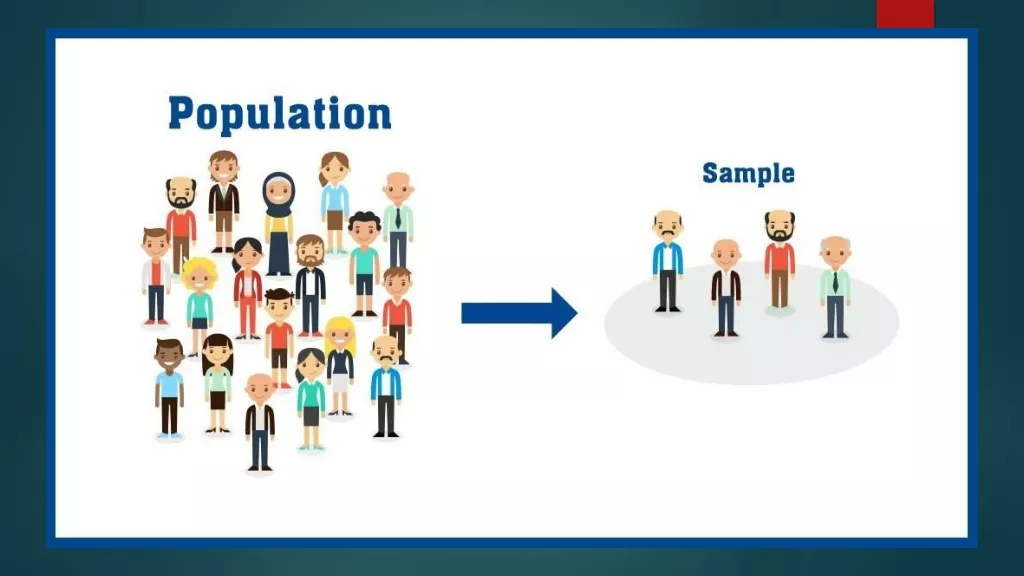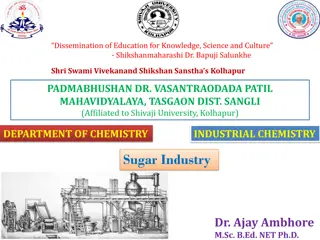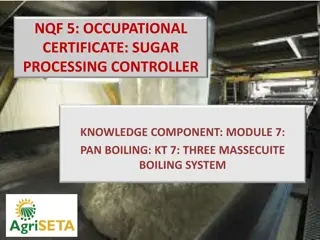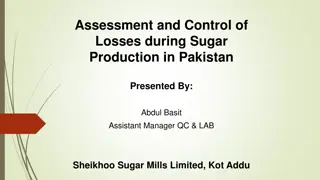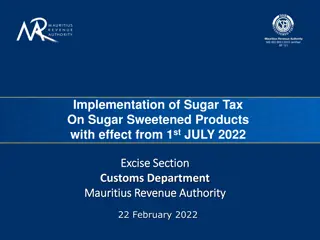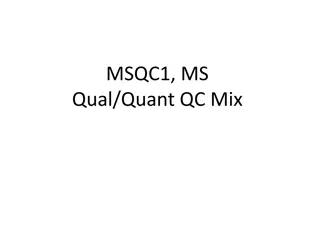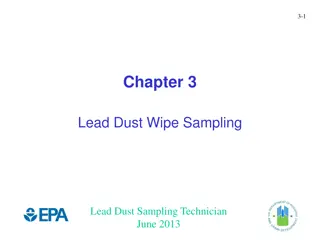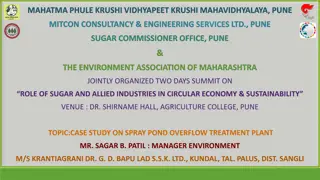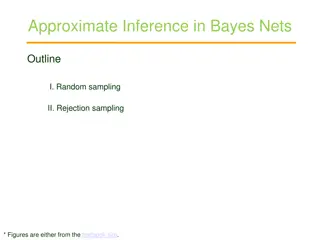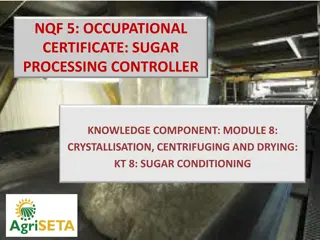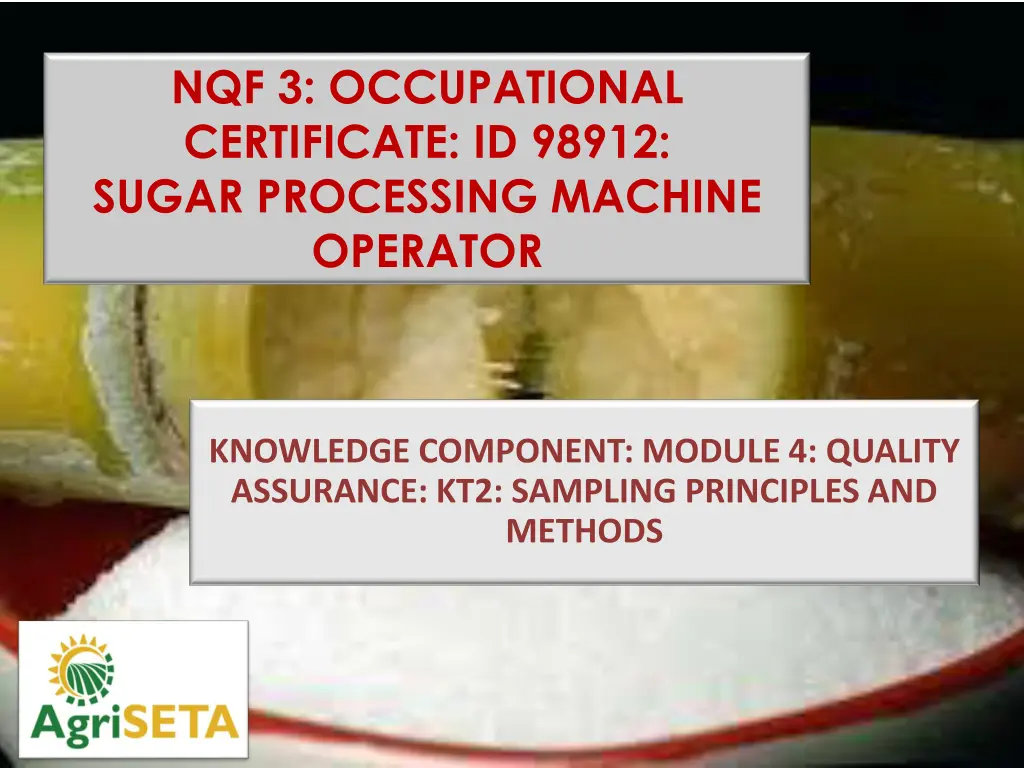
Essential Sampling Principles for Quality Assurance in Sugar Processing
Enhance your understanding of representative sampling in sugar processing quality assurance. Learn the importance of accurate samples, avoiding bias, and maintaining reliability for dependable results throughout the production line.
Download Presentation

Please find below an Image/Link to download the presentation.
The content on the website is provided AS IS for your information and personal use only. It may not be sold, licensed, or shared on other websites without obtaining consent from the author. If you encounter any issues during the download, it is possible that the publisher has removed the file from their server.
You are allowed to download the files provided on this website for personal or commercial use, subject to the condition that they are used lawfully. All files are the property of their respective owners.
The content on the website is provided AS IS for your information and personal use only. It may not be sold, licensed, or shared on other websites without obtaining consent from the author.
E N D
Presentation Transcript
NQF 3: OCCUPATIONAL CERTIFICATE: ID 98912: SUGAR PROCESSING MACHINE OPERATOR KNOWLEDGE COMPONENT: MODULE 4: QUALITY ASSURANCE: KT2: SAMPLING PRINCIPLES AND METHODS
Background Quality control and quality assurance depends on: Taking representative and accurate samples along the production line The laboratory analysis of the samples The results of the analysis monitored Corrective action taken if required Every employee on the factory floor is responsible for taking samples daily, weekly and monthly
Representative Sampling Samples must be representative of the material being sampled. A representative sample is a true reflection of the bulk material. A biased sample is a sample that is not representative. It is pointless to analyse perfectly a sample that is not representative It is pointless to sample and analyse perfectly and then make errors in the calculation of results.
Representative Sampling (cont.) When taking a sample of product (say juice) ensure that you have not included some stagnant ( old ) product that may have been trapped in the sampling pipe. Beware of using containers and lids that are contaminated i.e. dirty or wet. Do not leave samples to stand as they will deteriorate due to chemical and bacterial degradation.
Representative Sampling (cont.) Keep samples covered so that they do not lose moisture to the atmosphere or become contaminated with dirt and other substances (Use an up-side down watch glass for this purpose if the vesicle is small enough - or keep the sampling container lid closed until analysis). Before sub-sampling a product for analysis, mix it thoroughly first since many products contain substances that settle to the bottom. Taking a quantity from the top would then yield a biased sample. Examples are: juice, massecuite, molasses, sugar etc.
Representative Sampling (cont.) Reliability Representative sampling needs to be reliable, from validation of the raw ingredients to quality testing at each key processing stage. It is the only way to ensure confidence in food testing results. Accuracy Representative sampling will allow for dependable ingredient analysis and traceability, it must be accurate, and the way samples are collected needs to be efficient without introducing bias.
Representative Sampling (cont.) Ingredient verification Representative sampling at the control points of a quality assurance process will assist to verify that the parameters of the product being produced is according to the standards required at that point. Product traceability Tracking and verifying ingredients from farm to final product throughout the supply chain requires a statistically sound sampling plan. A product tracing plan can help organize the documentation of the production and distribution chain of the product and allow for the efficient collection of data required by the traceability system.
Sampling Techniques Good sampling techniques ensures that the sample taken represents the material from which it is taken in an unbiased manner. The nature and importance of the material will govern the sampling specification as to size and frequency. It is easier to obtain a small representative sample if the material is homogeneous, like clarified juice, than if it is a product of mixed composition like cane.
Sampling Techniques (cont.) Where great accuracy is not required, catch samples taken at fairly large time intervals will often be adequate, particularly when the variability in the composition of the material to be sampled is relatively small. However, where great accuracy is required, continuous sampling should be employed and care should be taken that the ratio between the mass of the fraction of the sample extracted in each unit of time and the mass of the material it represents, is constant.
Sampling Techniques (cont.) It is sometimes better to take frequent catch samples than a continuous sample, for example, it is desirable to obtain information on the variability of the composition of the material. Catch samples are also taken when there is possibility that a continuous sample will deteriorate during the sample period. Cleanliness of sampling devices and sample receptacles is essential. This calls for a planned and regular programme of cleaning.
Sampling Techniques (cont.) Duplicate sets of samplers and receptacles will greatly facilitate cleaning operations and must be provided wherever possible. Sample receptacles should be seamless and constructed of stainless steel or copper and must be covered to minimise evaporation and contamination. The importance of mixing the primary sample before sub-sampling cannot be over stressed and details are given below, under the procedures described, for the various products.
Sampling along the Sugar Production line Sampling should be done of: Cane Syrup Remelt Final bagasse First expressed juice Mixed juice Clarified juice Filter feed (mud) Filter cake Filtrate A-, B- and C-massecuite Magma A- and B-molasses Final molasses B-, C1- and C2-sugars A-sugar Review each sampling procedure in the learning resource
Sampling Equipment Consider each of the following pieces of equipment (See learning resource for detail): Electronic cane trackers Cane samplers Cane sub-samplers Screw conveyors Motor control panel Logic control panel Sample shredder Final bagasse samples Mixed juice samplers Cold juice Hot juice Mixed juice sampler insoluble solids Juice mixer Molasses sampler Sugar sampler Grab sampler for whole stick cane
Handling and Storage of Samples Packaging Check sample containers for leaks Outer surfaces must be clean and dry Caps and stoppers may need replacement if worn Fill liquid sampling containers to 90% Sealing Sample container may need to be sealed To prevent unauthorised or inappropriate handling of samples To ensure integrity of contents Seal must be firmly attached and stable Important to safeguard chain of evidence
Handling and Storage of Samples (cont.) Marking Labels must be legible and permanent Health and Safety regulations must be observed Warning signs, markings and symbols indicating potential hazardous content must be affixed to hazardous samples Documents accompanying samples Documentation required will be set by company policies and procedures The company QMS may specify: Who is responsible for accepting samples for storage and transport for analysis, and record keeping; Who is responsible for monitoring the sample storage deadlines; Who is responsible for sample disposal after expiry of these dates; Who is responsible for ensuring that the storage conditions for the samples are met at all times.
Sample Records and Labels The markings on labels must be: Clearly legible Permanent Unable to be deleted or substituted or altered during storage, handling and transport of samples. Health and safety regulations must be observed. Warning signs, markings and symbols indicating potential hazards should be placed on packages holding samples of hazardous goods/compounds. Documents such as waybills that accompany a sample must be kept in line with rules laid down by the company Quality Assurance policies and procedures.
Sampling Frequency Different stages of the sugar process require sampling (for quality control purposes) at different frequencies. Whole Stick Cane: A representative sample is taken per consignment. Final Bagasse: Because of the difficulties of continuous sampling of bagasse, catch samples are taken at regular intervals. A sample of bagasse should be taken at a predetermined time every hour. If the mill is not crushing at the sampling time, no sample shall be taken for that hour.
Sampling Frequency (cont.) Mixed juice: For Pol, Brix and sucrose analysis, the sample must be collected continuously over an hour (pooled sample per hour), every hour throughout the week. For Insoluble solids determination, the sample is taken each hour throughout the shift. For reducing sugars and pH a four hour composite sample is made from the sample taken for pol and brix determination. Clarified juice: Sampling is conducted every hour.
Sampling Frequency (cont.) Filter feed (mud): pH: A catch sample is taken every hour from each mud pump Brix, Bagacillo and suspended solids % feed (for the determination of bagacillo ratio and filter retention): A series of catch samples of the mud feed to the filters is taken for the duration of the test at a point after the addition of the bagacillo used as filter aid. Pol and insoluble solids (press water clarifier mud only): Take a catch sample once an hour. Filter cake Pol and moisture: A catch sample is taken every hour from the full width of each filter.
Sampling Frequency (cont.) Filtrate Brix and Pol determination: A catch sample is taken every 4 hours using the copper container. Brix and mud solids % filtrate (for the determination of filter retention): A series of catch samples is taken for the duration of a test. Syrup: A catch sample is taken hourly from the take-off pipe situated on the delivery side of the pump. Remelt: A catch sample is taken hourly from a short take off pipe with stopcock, after the brix controller.
Sampling Frequency (cont.) A-, B- and C- massecuite: Using the brass container, take catch samples at regular intervals from the gutter, neglecting the first fraction of the strike before commencing sampling. Magma: Catch samples are taken as required. A- and B- Molasses: Catch samples are taken from the blow up tanks as required.
Sampling Frequency (cont.) Final molasses: A sample is collected continuously over 2 hours. B-, C1- and C2- Sugars: Take the samples on conservative machines over a period of 2 hours. A-Sugar: Samples are best taken automatically with a semi-continuous sampler over an hour.

